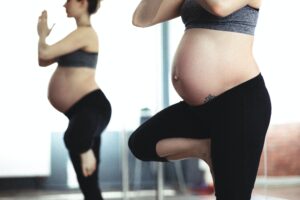I’ll give the answer away early………..it’s yoga!
Wait, don’t go……I’m not talking ‘ommmmmmmmmmmm’ kind of yoga, I’m talking pregnancy-specific yoga, which you can do at home, wearing your PJs (if you wish). You don’t have to be a yoga expert to benefit from it during and after childbirth. I started yoga for the first time when I was about 14 weeks into my first pregnancy. I didn’t do it to change my mindset about the birth, I don’t do it to clear my head and reduce stress associated with pregnancy, I didn’t even do it because anyone told me it would help. I did it simply because I wanted to feel more flexible and stronger on the day that I went into labour………..and boy did it help!
Let me tell you what this ‘doing yoga’ actually involved….
During my first pregnancy I was working full time (about 50 hours a week) but also trying to stay as active as possible. I would walk with my partner in the evenings and fit in an online yoga session 3-4 times a week. I would choose the length of my sessions based on how I was feeling. I might do 45 minutes if it was the weekend (and I had spare time and energy) but often in the week I would squeeze in a 15 / 20-minute session because that’s all I felt like doing! I found the sessions were only as easy or hard as you made them yourself, you could stretch further if you wanted, you could hold positions ‘deeper’ if you wanted and you could do it all without the modifications…… if you wanted! But you don’t have to push yourself if you don’t want to. The main thing was that I was doing it and I knew that it felt good. I noticed over the months that I was getting gradually better at certain elements. My balance had definitely improved, the strength in my arms and legs was noticeably different and I was without doubt way more flexible than before I became pregnant.

The day I had my baby:
The day of my labour came and I went into it totally blind, I didn’t prepare, I didn’t read books, I didn’t listen to podcasts and I didn’t practice breathing exercises, I just let nature take its course. My plan was to go into a birthing unit and hang out in a birthing pool as long as possible and that I did. My labour was 23 hours in total, I think 7 of those hours were in water. By the end of my labour, when I was pushing the baby out, I still felt strong, I felt flexible and I had my baby without pain relief, without a single tear (or injury of any kind) and without any intervention. Just how I wanted it! Maybe I was one of the lucky ones? Maybe it was because I didn’t know what to expect so was a little more relaxed than others with lots of knowledge? I certainly felt as though the water helped but after looking at lots of research, it would seem that water doesn’t have a big impact on the outcome of the birth only the mother’s perception of pain (I know when I had to get out of the water for an examination I felt my pain levels increase massively).

Why am I telling you all of this?
Certainly not because I want to tell everyone how amazing I am with my ‘no tear, no medication, hiccup-free birth’. All births, no matter the circumstances are miraculous (to say the least), everyone’s circumstances are really different and that can have a big impact on labour and birth. However, I thought by sharing this information it might help pregnant ladies make a decision about whether or not to exercise and what exercise might suit them best.
The important bit; what does scientific research tell us about Yoga in pregnancy?
As many of you who read my blogs know by now, I flippin’ love research! Telling people to do things that may or not help without any scientific backing, to me, is madness!! If research studies don’t support ‘it’ (whatever ‘it’ is) then don’t do it, use it or try it! Simple! So, here are some of my favourite studies that I came across (a lot of these are on the ‘Pain in the Bump‘ website) while looking into all of the things that can help pre and postnatal ladies.
Here is a study that was carried out in 2020. The researchers interviewed 200 women who were pregnant for the first time. They looked at the impact that yoga had on their pregnancy, labour and birth. They reported that the subjects who followed regular antenatal yoga sessions had significantly lower rates of caesarean section, lower weight gain, higher new born infant weight, lower pain and overall discomfort during labour, lower back pain throughout pregnancy and earlier post-partum recovery compared to those who did no specific exercises or only walked during pregnancy.
Here is a study that looked into the effects of yoga on pregnant women during the pandemic. The authors found that pregnancy-related complications were becoming more prevalent now, due to the sedentary lifestyle, restricted physical activity and growing stress associated with the covid-19 outbreak. They found that yoga was effective for combating stress and anxiety whilst also boosting immunity in pregnant working women confronted with the COVID-19 pandemic.
Another study that I really enjoyed reading was this one published in 2020, titled simply: ‘The effects of yoga on pregnancy’. This was a fairly large-scale systematic review, giving a good overall, unbiased view of the literature available. They concluded that antenatal yoga is safe and effective in decreasing stress levels, anxiety scores, depression scores and pain response, as well as increasing maternal immunity and emotional-wellbeing.
If you want to get a little more specific with your research then have a look at these:
This study was carried out in 2017. The authors wanted to find out if yoga had an impact on labour pain and delivery outcomes. This was a fairly small, randomised controlled trial, but results were promising. They found that yoga helped decrease pain perception at 3-4 cm of dilatation. They reported a decreased frequency of labour induction in comparison with control groups. They found that the mode of delivery of the yoga group resulted in a lower percentage of caesarean sections and they also found that the yoga group experienced a shorter duration of the second and third stages of labour. If that doesn’t make you want to do yoga for a few months then I don’t know what will!!
This study is a little older (2015) and is a medium-scale systematic review. Their findings suggested that prenatal yoga can help reduce pelvic pain, improve mental condition (stress, depression, anxiety) and improve perinatal outcomes (obstetrical complications, delivery time, etc.).
I also found this study which isn’t pregnancy related (it’s investigating the effects of yoga on office workers) but it looked at yoga sessions that were just 10 minutes long, done daily (which I liked the sound of). The researchers found that after just 1 month of these 10-minute sessions, significant reductions were observed in the discomfort of eyes, head, neck, upper and lower back, right wrist and hips/buttocks.

A quick summary:
I believe that doing yoga throughout my pregnancy helped me with the outcome of my birth. And it isn’t just me who thinks that, there is mountains of research out there about the benefits associated with doing yoga during pregnancy. There are NO studies that have suggested that yoga is unsafe and it is an activity that can be started at any point in your pregnancy journey (as long as it is an antenatal class) and you certainly do not need to be an expert (or even close) to start some yoga.
Online classes that I like:
There are a lot of online exercise classes now, especially since the pandemic hit. I’ve scoured the internet to find ones that I like for pre and postnatal yoga and put together my Top 5, have a look at them here.
Another great thing about yoga is that you don’t need any equipment! Some of the classes advise that you can use a ‘block’ but you can usually find an alternative way to do the exercises without it or you can just use something in your house that is similar (I use my sons foam bricks).
There are some free classes available in my Top 5 also, so you could give one or two of those a go before purchasing a programme or membership and see if you like it. Maybe more importantly, see if it is the right exercise for you and your pregnancy.




